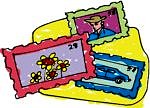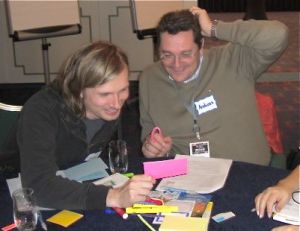Making Connections with Postcard Partners from “The Ten-Minute Trainer”
 Do you need a new, high-energy opening activity to begin a class or training? “Postcard Partners” will connect learners-to-learners and learners-to-content in an interactive, fun, and memorable way.
Do you need a new, high-energy opening activity to begin a class or training? “Postcard Partners” will connect learners-to-learners and learners-to-content in an interactive, fun, and memorable way.
What Does a “Postcard Partners” Activity Do?
As a connecting activity at the opening of a training, this is one of the best ways to get learners physically moving while solving a problem – that of finding their postcard partners and then answering a topic-related question. With Postcard Partners, learners:
- Connect with each other and with the topic.
- Form a positive learning community for the duration of the training.
- Focus on the topic: what they already know, questions to answer, or issues to discuss.
- Begin a dialog about the training concepts.
- Move around the room, which raises the physical energy level of the group.
Basically, each learner chooses a postcard piece, then stands and finds her partner or partners who have the other pieces that go with her postcard. When they find each other, they form standing pairs or triads, and put their postcard together. They turn the card over and take a couple of minutes to answer a topic-related question or discuss a topic-related issue that is printed on the back of the card.
 Getting Ready for “Postcard Partners”
Getting Ready for “Postcard Partners”
Materials: Before the training begins, purchase (or make) a set of postcards with pictures on the front. Although different postcard pictures make the activity more interesting, you can also use colored index cards.
If you cut the postcards in half, you will need enough postcards for one-half the group size. Or you can simply have duplicates of postcards so participants match their postcard with others who have the same photo or graphic.
Print a sentence on the back of each card. The sentences can be the same or different for each postcard. They can be topic-related questions to answer or issues to discuss. Examples are:
What are three facts you already know about the training topic?
What is a question you want answered today concerning this topic?
What are two things you want to be able to do as a result of this class?
Here is an issue related to this topic (state the issue). What is your opinion about this?
Discuss this statement (make a statement about the topic).
What is an issue that you feel is crucial to this topic?
If you decide to cut postcards in half, cut each card a different way – diagonals, zig-zags, waves, straight, curved – so that it is easier for partners to find each other. Put the mixed-up card pieces into a small bag or box. If you aren’t sure how many participants will be in the training, estimate the number and then make a few extra cards just in case. Participants can always share a piece too.
If each participant gets one whole postcard, make sure there are enough cards for everyone to have one.
Set-Up: The room must be large enough to accommodate movement with enough space between tables, chairs, and walls for people to walk as they hunt for their partners.
Group Size: The class size can be small (at least 6 people) or large (up to 30). As the group size gets bigger, it takes more time for learners to find their partners, and more time to discuss and share the questions/statements. It also takes more time for you to make the postcards.
Time: 10 minutes. To do a 5-minute version, skip the sharing step (see the activity instructions), or include it later in the training in the form of a 60-second “Shout-Out.” If the group is small enough (under a dozen), direct learners to introduce their partners to the whole group before they share their postcard discussions.
“Postcard Partners” Instructions
Have a small bag or box filled with postcards (or postcard pieces) by the door. Tell participants to take a postcard (or piece) from the bag/box as they enter the training room. If you have table groups, place the postcard pieces on the tables. If anyone ends up without a piece or a partner, have that person join one of the other postcard groups.
Tell participants to find their postcard partner(s) by moving around the room and checking postcards until they find the ones that complete the pieces they are holding (or the ones that match their cards). This will take about a minute or two, depending upon the size of the group.
When participants have found their postcard partners, they put the card pieces together and then turn the card over. Give them about 3 minutes to discuss the question/statement on the back.
Debrief the activity by having partners report out to the whole group. They can read the card question/statement and then verbally respond. Or they can simply share what they discussed. If the group is large, ask for a few volunteers to report to the whole group – not every pair or triad needs to report. This will take about 4 – 5 minutes.
Then have postcard partners thank each other and give each other a round of applause.

“Postcard Partners” Variations
Colored Index Cards: The simplest variation is to use colored index cards as postcards. Participants form standing groups with others whose index cards match theirs in color. Then they discuss the posted question for their card color. You post the topic-related questions for them to discuss on a slide or chart.
Regional or Thematic Postcards: Use postcards that picture the location the training is in (town, city, region, state). Or use cards related to a training concept.
Homemade Postcards: Make up your own postcards using blank index cards, large stick-on labels, and graphics from computer clipart or from digital photos. If your training has an overall theme, make the postcards theme-related. You can also glue magazine pictures onto index cards or construction paper.
Learner-Created Postcards: Working in pairs, learners can also make and cut their own postcards. They put them in the bag or box, mix them up, and draw them out to do the activity. If they get their own, they put it back and choose another.
Postcards to Review or Celebrate: Learners can also do the activity as a review in the middle of a class or training, or as a celebration for the closing.
Connect Again: If the class or training is a few hours or one – two days, have learners reconnect with the same postcard partners at the closing of the entire learning experience to discuss what they have learned.
 Source of “Postcard Partners”
Source of “Postcard Partners”
The activity is from “The Ten-Minute Trainer: 150 Ways to Teach It Quick and Make It Stick.” You can use the 150 activities described in the book with anyone you teach, train, instruct, or coach (even your own kids!).
If you want more of these learner-centered, brain-friendly activities, consider attending one of the global “Training from the BACK of the Room” classes being offered by my outstanding team of TBR Certified Trainers – click HERE or HERE for the 2018 – 2019 calendar of public TBR classes. And be sure to check back – classes are added monthly.